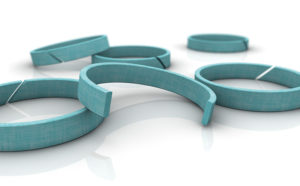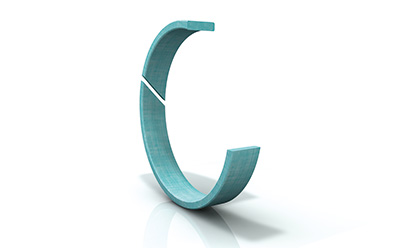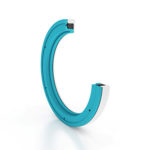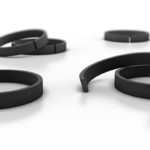Wear rings can be an integral part of a hydraulic system, as they absorb side loads and eliminate metal-to-metal contact, extending system life.
Contributed by Tom Zozokos, Product Manager, Trelleborg Sealing Solutions Streamwood and Beth Figliulo, Fluid Power Segment Manager, Trelleborg Sealing Solutions Americas

Wear rings, whether metal, thermoplastic, thermoset or PTFE-based, can be an integral part of a hydraulic system. At their most basic, wear rings absorb the side load forces in a piston and/or rod hydraulic cylinder, while eliminating metal-to-metal contact. Generally speaking, wear rings can extend the life of a hydraulic system: it’s faster and less expensive to replace a wear ring than an entire cylinder. Although there are applications where metal wear rings are appropriate, there are numerous benefits of non-metallic rings for hydraulic cylinders in fluid power applications such as off-highway, material handling, industrial machines, mobile hydraulics, and agricultural equipment. These are:
- High load-bearing capacity
- Favorable friction behavior
- Damping of mechanical vibrations
- Good wiping effect
- Protection of seal against “dieseling” (hydraulic fluid flowing too quickly across the cylinder)
- Elimination of local stress concentrations
- Easy installation
- Less downtime, due to less damage to rods or pistons, and longer product life
Non-metallic wear ring materials include polytetrafluoroethylene (PTFE) based compounds, as well as thermoset plastics and thermoset options. Each has its own specific characteristics.
PTFE-based wear rings provide extremely low friction within systems and are particularly well suited in dry-running applications. They can be mated with steel, aluminum and cast iron. The smoothness of PTFE-based wear rings means such little abrasion takes place that, in some cases, less expensive hardware can be used in a system.

Additionally, PTFE-based rings, due to their low friction characteristics, help lower the incidence of stick-slip when starting up the system. Common uses of PTFE-based wear rings include equipment operating at high temperatures and pressures.
Thermoset rings have outstanding wear resistance properties and are designed to offset heavy loads at low speeds. They address application demands for strong, light, durable rings. Although thermoset rings are dense, they are elastic in comparison to metal rings.
Wear rings are available up to 60 in. in diameter, and larger diameters can be manufactured from strip. Most of the rings can be mated with steel, hard chrome plated surfaces and cast iron. Example applications include tensioner cylinders, injection molding hydraulic systems and aerospace landing gear.
Thermoplastic wear rings are the workhorses of hydraulic systems, and in many systems, they are temperature resistant and can provide a high level of performance at a more affordable price than PTFE-based or thermoset wear rings.
Most can be mated with steel, hard chrome plated surfaces and cast iron. Two popular applications for thermoplastic rings are for internal valves and compressor components.
Selection is the name of the game
Choosing the best material for your application is a matter of evaluating the type of application, the size of the load within the system, the installation space, and the mating surface.
Usually, wear rings are supplied as split rings or strip material offered in a roll or precut to size. Chamfered edges are an option that facilitate installation and prevent edge forces from becoming too high in the corner radii of the grooves.
There are several types of split designs:
- Scarf cuts (also called angle cuts) are standard for the hydraulic applications. The angle reduces the edge loading on the ends of the ring and is preferred for linear systems.
- Straight cuts (also called butt cuts) are often seen on strip or net molded rings and are most often used in rotary applications.
- Step cuts provide the best wear ring coverage and can act as a buffer in the system against pressure spikes, but usually at an additional cost.
Maximizing surface contact

Since thermoplastic rings are injection molded, it is not uncommon to see parts shrink unevenly during the cooling process, especially if the tooling design is not optimal. The shrinkage can cause a shape that’s thinner in the center than on the ends (often referred to as “dogboning”).
One way to quickly test a wear ring for dogboning is to lay it against a flat surface and visually assess it for daylight shining through. Of course, dogboned wear rings can be easily discovered during prototype tests. In extreme cases, dogboned rings cannot be installed. In less extreme cases, they cause higher friction than expected and/or act as a wiper, so hydraulic fluid doesn’t flow properly.
It is always best to work with a reputable supplier that can avoid dogboning in their design and tool making processes.
Understanding wear rings’ performance
Some wear rings that are on the market are made for volume commercial applications. This can, in certain circumstances, mean that the tolerance to which they are machined may be wide, typically up to 0.005 in. of the total wall.
Tight machining produces wear rings with tighter clearances and less buildup of tolerances. In terms of total cost of ownership, this expense in some applications can pay dividends; for example, within systems that will be marketed as high performance and judged on their longevity. For systems that are not expected to be used for long periods, cost savings may be achieved by specifying larger-tolerance commercial rings rather than precision ones.
In either case, the quality of the injection molding is an important aspect to consider when choosing a wear ring supplier. Consistency in wear-ring performance means faster installation and increased life between changeovers, something hydraulic cylinder manufacturers strive for. Consider also that selecting the best wear ring for your application can greatly increase its effectiveness. It is always best to work with a supplier that can advise you based on a high degree of expertise in fluid power sealing systems.
Trelleborg Sealing Solutions
tss.trelleborg.com







Leave a Reply